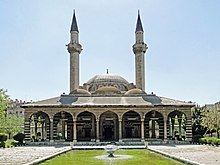Takiyya al-Sulaymaniyya
The Takiyya al-Sulaymaniyya (dt. Tekkiye Süleymans , also Tekkiye Mosque or Sultan Sulayman Mosque , Arabic التكية السليمانية Takkiya Sulaymaniyya 'Monastery of Suleyman', Turkish Tekkiye Camii ) is areligious complex in Damascus builtby the Ottoman architect Sinan . It is located near the National Museum and consists of a mosque with an attached Koran school ( madrasa ).
history

After the victory over the Mamluks in Syria and Egypt, the Ottoman Sultan Selim I chose the Ablaq Palace, the residence of the Mamluks prince Baibars , as his residence during his stay in the region in the winter of 1516/17. In gratitude for the victory, Selim donated a mosque near the grave of the Sufi master Muhyī d-Dīn Ibn ʿArabī , whom Selim worshiped. Selim had a mausoleum with a dome built over the grave and built a Friday mosque with Imaret (poor kitchen). The mosque constructed as a hypostyle with minarets bears the date 923-24 (1517-18) and was influenced by the Arabic style of that time. The architect was Shihab al-Din Ibn al-'Attar.
Today's Takiyya-al-Sulaymaniyya was commissioned by the Ottoman Sultan Suleyman I the Magnificent in 1554/55 . Suleyman was probably in Damascus because of the war against the Safavids . His sons Mustafa and Cihangir had died shortly before; the Sultan had had his son Mustafa executed shortly before. This is probably one of the reasons why he wanted to found a mosque for the salvation of his soul. He chose the site of his father's former palace in Damascus. The complex was completed between 1558/59. The governor Şemsi Pasha was in charge of the building supervision. The architect was Sinan, who probably did not travel to Damascus, but made the plans in Constantinople. He named Todoros as the executive architect. The work was done by Arab craftsmen from the region.
In addition, the construction of a madrasa began, which was only completed under the reign of Selim II in 1566/67 and was subject to the Hanafites . In 1567, the Governor General of Damascus received a letter from the Ottoman Sultan calling for a Tekke to be built . It is not known when this was built. In a listing of buildings under Süleyman's regime from 1596, the mosque, the madrasa, the imaret, a caravanserai and the tekke are also mentioned.
In the courtyard garden there are graves of representatives of the Ottoman dynasty who were expelled from Turkey after the proclamation of the Republic , including the graves of Mehmed VI. , the last sultan of the Ottoman Empire and Şehzade Mehmed Seyfeddin Efendi .
architecture
The construction of the mosque combines the typical Damascus black and white architecture with Ottoman domes and two slender minarets. The outer walls of the complex measure 100 × 150 meters. The mosque has a prayer room with 256 square meters and was built on a square floor plan. A portico with three bays on twelve columns with muqarnas capitals was built above the entrance in the north with a muqarnas vault . In the west and east there are living rooms for guests with an open columned hall in front of them. To the north of the site is the soup kitchen, which is framed by a caravanserai with numerous small domes to the west and east. The buildings form a rectangle with a garden with a water basin for ritual ablutions. In the east, the madrasa adjoins it via a narrow souq . The main building takes on the style of the mosque with a dome and forms a rectangle with the outbuildings with the school rooms.
Web links
- Takiyya al-Sulaymaniyya , archnet.org
literature
- M. Baha Tanman: Süleymaniye Külliyesi. (PDF) In: İslam Ansiklopedisi. Türkiye Diyanet Vakfı, accessed December 9, 2014 (Turkish).
- Johannes Odenthal: Syria. High cultures between the Mediterranean and the Arabian desert. 4th edition, DuMont, Cologne, 1988, p. 99. ISBN 978-3-7701-3978-1
Individual evidence
- ^ Gülru Necipoğlu: The Age of Sinan: Architectural Culture in the Ottoman Empire . Reaction Books, London 2005, ISBN 1-86189-244-6 , pp. 222-230, here pp. 222 f.
- ↑ Gülru Necipoğlu (2205), p. 224 f.
- ^ Gülru Necipoğlu (2205), p. 225
Coordinates: 33 ° 30 ′ 44.3 " N , 36 ° 17 ′ 28.8" E

